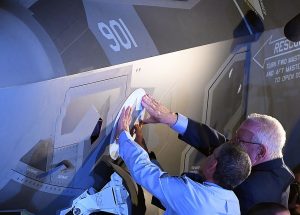The F-35 Joint Strike Fighter Aircraft: What It Brings to the IAF

Israel receives its first two fifth-generation F-35 Joint Strike Fighters, Nevatim Air Force Base, December 12, 2016, photo via US Embassy Flickr
BESA Center Perspectives Paper No. 629, October 29, 2017
EXECUTIVE SUMMARY: The F-35 Joint Strike Fighter aircraft is about to become fully operational in the Israel Air Force. An intelligence-gathering machine in a league of its own, the F-35 can evade the various enemy radar systems deployed in the northern arena. It will play a key role in Israel’s quest to stop Iran and its proxies from creating a threatening military outpost in Syria, and will also help Israel guard against Hezbollah’s heavily armed fortress in Lebanon. The new platform will also boost Israel’s long-range capabilities.
The F-35 Joint Strike Fighter jet is poised to become a key tool to help Israel stop Iran and its proxies from creating a threatening military outpost in Syria. It will also play a leading role vis-à-vis Hezbollah’s heavily armed fortress in Lebanon.
The Lockheed Martin-produced aircraft, which is due to become fully operational in December of this year, brings with it a number of new capabilities that ideally suit Israel’s requirements in terms of monitoring and, when necessary, striking Iranian-Hezbollah-Syrian military targets in Syria and Lebanon. The aircraft is well suited for the mission of selectively targeting the ongoing Iranian-Hezbollah weapons trafficking program.
The F-35 is an intelligence-gathering machine in a league of its own. It is able to deploy a range of sensors to gather detailed information on events on the ground. It can fuse unprecedented quantities of intelligence automatically, then share it with other aircraft and with the Israel Air Force’s (IAF) ground control stations.
This intelligence can then be sent to Israel’s Military Intelligence Directorate for further analysis and for the creation of a large databank of targets.
This will provide Israel with a significantly enhanced picture of the activities of Iran, Hezbollah, and the Assad regime throughout the northern arena. It will also give Israel a strong starting position in the event of an escalation of the security situation, since these targets can be struck in the future.
In mid-October, an Assad regime SA-5 surface-to-air missile battery detected and fired upon Israeli jets, which were reportedly on an intelligence-gathering mission over Lebanon. That incident is an indication of a growing Iranian-Assad-Hezbollah determination to harass Israel’s intelligence operations.
But the F-35, with its stealth capabilities, should be able to evade enemy radar detection, making such crucial missions smoother.
Israeli F-35s could be sent to gather intelligence in contested air space filled with hostile radar systems and avoid detection.
IAF officials say they are also working on getting the F-35 to communicate effectively with the older, fourth-generation F-16s and F-15s. In combat situations, the F-35s would be able to spearhead operations, moving first into contested battle zones, striking enemy targets before being detected, and sending back valuable data to the fourth-generation aircraft.
Such capabilities will be critical going forward, as both Syria and Lebanon have become filled with a variety of surface-to-air missile systems. Several different types of missile batteries are in the possession of Hezbollah and the Assad regime.
In recent years, Russia has also stationed its advanced S-300 and S-400 batteries in Syria.
The F-35’s value in this increasingly complex and challenging environment is clear. It becomes even more pronounced when examining Israel’s need to improve its long-range strike capabilities in the event of a conflict with Iran. The F-35 has unique long-range capabilities.
By 2024, Israel will have two full squadrons of F-35 A jets – a total of 50 aircraft. The last 17 of these jets were purchased by Israel in August of this year.
The Planning and Organization Department within the IAF is in the midst of intensive preparations aimed at integrating the F-35 into daily operations.
The IAF expects the new aircraft to affect the way the rest of the air force operates and to boost Israeli capabilities across the board. The IDF’s ground forces, too, could experience its benefits. The F-35’s data could be relayed quickly to units on the ground, improving their lethality and battle space awareness.
For now, the IAF is continuing to gather vast quantities of intelligence and engage in low-profile action against the radical Shi’ite axis to the north – but it is also planning for the possibility of open conflict. If such conflict unfolds, the IAF will unleash waves of heavy firepower never before seen in the region’s military history. The F-35’s unique awareness of its combat environment will let it take a leading role in such operations.
Yaakov Lappin is a Research Associate at the Begin-Sadat Center for Strategic Studies. He specializes in Israel’s defense establishment, military affairs, and the Middle Eastern strategic environment.
No comments:
Post a Comment
Thanks for commenting. Your comments are needed for helping to improve the discussion.